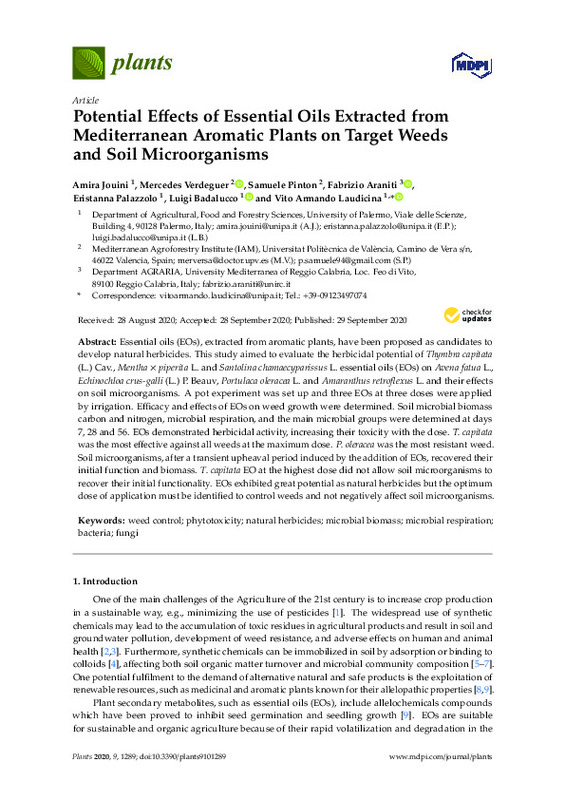JavaScript is disabled for your browser. Some features of this site may not work without it.
Buscar en RiuNet
Listar
Mi cuenta
Estadísticas
Ayuda RiuNet
Admin. UPV
Potential Effects of Essential Oils Extracted from Mediterranean Aromatic Plants on Target Weeds and Soil Microorganisms
Mostrar el registro sencillo del ítem
Ficheros en el ítem
| dc.contributor.author | Jouini, Amira
|
es_ES |
| dc.contributor.author | Verdeguer Sancho, Mercedes María
|
es_ES |
| dc.contributor.author | Pinton, Samuele
|
es_ES |
| dc.contributor.author | Araniti, Fabrizio
|
es_ES |
| dc.contributor.author | Palazzolo, Eristanna
|
es_ES |
| dc.contributor.author | Badalucco, Luigi
|
es_ES |
| dc.contributor.author | Laudicina, Vito Armando
|
es_ES |
| dc.date.accessioned | 2021-11-05T14:13:02Z | |
| dc.date.available | 2021-11-05T14:13:02Z | |
| dc.date.issued | 2020-10 | es_ES |
| dc.identifier.uri | http://hdl.handle.net/10251/176530 | |
| dc.description.abstract | [EN] Essential oils (EOs), extracted from aromatic plants, have been proposed as candidates to develop natural herbicides. This study aimed to evaluate the herbicidal potential of Thymbra capitata (L.) Cav., Mentha x piperita L. and Santolina chamaecyparissus L. essential oils (EOs) on Avena fatua L., Echinochloa crus-galli (L.) P. Beauv, Portulaca oleracea L. and Amaranthus retroflexus L. and their effects on soil microorganisms. A pot experiment was set up and three EOs at three doses were applied by irrigation. Efficacy and effects of EOs on weed growth were determined. Soil microbial biomass carbon and nitrogen, microbial respiration, and the main microbial groups were determined at days 7, 28 and 56. EOs demonstrated herbicidal activity, increasing their toxicity with the dose. T. capitata was the most effective against all weeds at the maximum dose. P. oleracea was the most resistant weed. Soil microorganisms, after a transient upheaval period induced by the addition of EOs, recovered their initial function and biomass. T. capitata EO at the highest dose did not allow soil microorganisms to recover their initial functionality. EOs exhibited great potential as natural herbicides but the optimum dose of application must be identified to control weeds and not negatively affect soil microorganisms. | es_ES |
| dc.language | Inglés | es_ES |
| dc.publisher | MDPI | es_ES |
| dc.relation.ispartof | Plants | es_ES |
| dc.rights | Reconocimiento (by) | es_ES |
| dc.subject | Weed control | es_ES |
| dc.subject | Phytotoxicity | es_ES |
| dc.subject | Natural herbicides | es_ES |
| dc.subject | Microbial biomass | es_ES |
| dc.subject | Microbial respiration | es_ES |
| dc.subject | Bacteria | es_ES |
| dc.subject | Fungi | es_ES |
| dc.subject.classification | BOTANICA | es_ES |
| dc.title | Potential Effects of Essential Oils Extracted from Mediterranean Aromatic Plants on Target Weeds and Soil Microorganisms | es_ES |
| dc.type | Artículo | es_ES |
| dc.identifier.doi | 10.3390/plants9101289 | es_ES |
| dc.rights.accessRights | Abierto | es_ES |
| dc.contributor.affiliation | Universitat Politècnica de València. Departamento de Ecosistemas Agroforestales - Departament d'Ecosistemes Agroforestals | es_ES |
| dc.description.bibliographicCitation | Jouini, A.; Verdeguer Sancho, MM.; Pinton, S.; Araniti, F.; Palazzolo, E.; Badalucco, L.; Laudicina, VA. (2020). Potential Effects of Essential Oils Extracted from Mediterranean Aromatic Plants on Target Weeds and Soil Microorganisms. Plants. 9(10):1-24. https://doi.org/10.3390/plants9101289 | es_ES |
| dc.description.accrualMethod | S | es_ES |
| dc.relation.publisherversion | https://doi.org/10.3390/plants9101289 | es_ES |
| dc.description.upvformatpinicio | 1 | es_ES |
| dc.description.upvformatpfin | 24 | es_ES |
| dc.type.version | info:eu-repo/semantics/publishedVersion | es_ES |
| dc.description.volume | 9 | es_ES |
| dc.description.issue | 10 | es_ES |
| dc.identifier.eissn | 2223-7747 | es_ES |
| dc.identifier.pmid | 33003485 | es_ES |
| dc.identifier.pmcid | PMC7600404 | es_ES |
| dc.relation.pasarela | S\419134 | es_ES |








